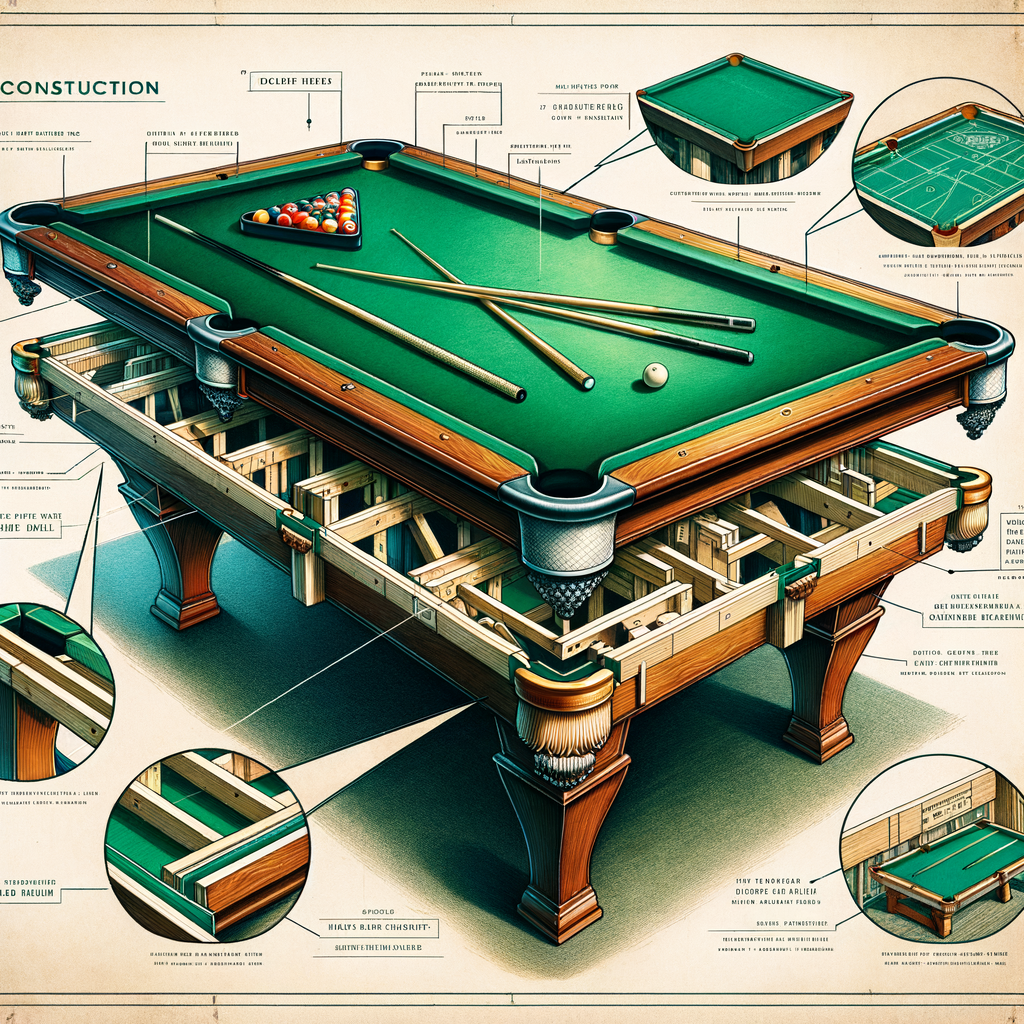
Introduction to Billiards Equipment
Billiards, a game loved by many, requires not just skill and strategy, but also the right equipment. In this section, we’ll explore the essential billiards equipment and understand why quality matters.
- Overview of Billiards Equipment
Billiards equipment primarily consists of a billiards table, billiard balls, cues, and a rack. The table is typically covered with a cloth and has six pockets. The balls, usually numbered from 1 to 15, are the targets of the game. The cues are the tools players use to strike the balls. The rack is used to arrange the balls at the start of the game.
Each piece of equipment plays a crucial role in the game. The table provides the playing surface, the balls are the objects of play, the cues allow players to interact with the balls, and the rack sets up the game. Without any one of these, the game of billiards would not be possible.
- Importance of Quality Equipment in Billiards
Quality equipment can significantly impact a player’s performance in billiards. For instance, a high-quality billiards table will provide a smooth and even playing surface, allowing for accurate shots. Similarly, quality balls will roll smoothly and predictably, while a good cue will offer better control and precision.
Moreover, quality equipment tends to last longer and withstand the rigors of the game better. This means that investing in high-quality billiards equipment can save you money in the long run, as you won’t need to replace your equipment as often.
In conclusion, quality equipment is not just a luxury in billiards – it’s a necessity. It can enhance your performance, improve your enjoyment of the game, and even save you money over time. So, whether you’re a casual player or a serious enthusiast, it’s worth investing in the best equipment you can afford.
Understanding Slate Tables: The Core of Billiards
Billiards, a game of precision and strategy, is enjoyed by millions around the world. A key component of this game is the table on which it is played. The quality and type of table can significantly impact the game. In this section, we will explore slate pool tables, their importance, and why they are considered the core of billiards.
-
- What are Slate Pool Tables?
Slate pool tables are billiard tables that use slate – a fine-grained, foliated, homogeneous metamorphic rock – as the surface beneath the cloth. This surface, also known as the bed, is where the balls roll and collide. The slate is usually around one inch thick and can be made up of one, two, or three pieces. The use of slate ensures a perfectly flat surface, which is crucial for a fair and accurate game.
-
- Why Slate Tables are essential in Billiards?
Slate tables are essential in billiards for several reasons. First, slate is a highly dense and durable material. This means it can withstand the impact of billiard balls without denting or warping, ensuring a smooth and consistent game every time. Second, slate doesn’t change shape or warp under different temperature or humidity conditions, unlike other materials. This makes slate tables a preferred choice for professional tournaments and serious players. Lastly, the weight of the slate keeps the table stable, preventing any unwanted movement during play.
In conclusion, slate pool tables offer a superior playing experience due to their durability, stability, and resistance to environmental changes. They are the heart of the game of billiards, providing a reliable and consistent platform for players to showcase their skills and strategy.
Billiards Table Materials: Slate vs Non-Slate Pool Tables
Slate in Billiards
The game of billiards is not just about the cue and balls; the table plays a pivotal role too. One of the most crucial elements of a billiards table is the material it’s made from, and slate is a popular choice. Let’s delve into the properties of slate and why it’s beneficial for billiards tables.
-
- Properties of Slate
Slate is a fine-grained, metamorphic rock that is derived from an original shale-type sedimentary rock. It is composed mainly of clay or volcanic ash. Here are some key properties of slate:
-
-
- Durability: Slate is known for its toughness and longevity. It can withstand the impact of billiards balls for many years without showing signs of wear and tear.
- Flatness: Slate naturally splits into flat pieces, making it an excellent choice for a smooth and level playing surface.
- Weight: Slate is heavy, which adds stability to the billiards table and prevents it from moving during play.
- Benefits of using Slate in Billiards Tables
-
Now that we understand the properties of slate, let’s explore why it’s beneficial for billiards tables:
-
- Consistent Gameplay: The flatness of slate ensures a consistent roll of the ball, which is crucial for a fair and enjoyable game.
- Long-lasting: Thanks to its durability, a slate billiards table can last for decades, making it a worthwhile investment.
- Professional Standard: Slate is the material of choice for professional billiards tournaments, so playing on a slate table can help you hone your skills to a higher standard.
In conclusion, slate’s unique properties make it an excellent choice for billiards tables. Its durability, flatness, and weight contribute to a consistent and professional gameplay experience. Whether you’re a casual player or aspiring professional, a slate billiards table can enhance your game.
Non-Slate Pool Tables
When it comes to billiards, the type of table you choose can significantly impact your game. One of the options you might come across is a non-slate pool table. But what exactly is a non-slate pool table, and how does it compare to its slate counterpart?
-
- What are Non-Slate Pool Tables?
Non-slate pool tables, as the name suggests, are billiards tables that do not use slate as the material for their playing surface. Instead, they utilize alternatives such as plywood, fiberboard, or Slatron. These materials are lighter and less expensive than slate, making non-slate pool tables a more affordable option for casual players and beginners.
-
- Comparison between Slate and Non-Slate Pool Tables
When comparing slate and non-slate pool tables, several key differences come into play. Let’s break them down:
| Slate Pool Tables | Non-Slate Pool Tables | |
|---|---|---|
| Material | Made from a solid piece of slate | Constructed from materials like plywood, fiberboard, or Slatron |
| Weight | Heavy and sturdy | Lighter and easier to move |
| Price | More expensive | More affordable |
| Performance | Provides a smooth and consistent playing surface | May not offer the same level of smoothness and consistency |
While slate pool tables are known for their superior playability, non-slate tables offer a more affordable and portable option. The choice between the two often comes down to your budget, space, and how serious you are about your billiards game.
Billiards Table Construction: The Role of Slate
Billiards, a game of precision and strategy, is played on a table that is a marvel of construction. The key component in the construction of a billiards table is slate. But what role does slate play in the construction of a billiards table? Let’s delve into this topic.
-
- How are Slate Pool Tables constructed?
Slate pool tables are built with a combination of wood and slate. The process begins with the construction of the table frame, usually made of solid wood. The frame provides the necessary support for the heavy slate top. The slate, which forms the playing surface of the table, is then carefully cut and leveled to ensure a perfectly flat surface.
Once the slate is prepared, it is placed on top of the frame. The slate is usually made up of three pieces, each one inch thick. These pieces are then sealed together with a special type of wax to create a seamless playing surface. The slate is then covered with a cloth, often made of wool, which provides a smooth and consistent surface for the balls to roll on.
-
- Why Slate is preferred in the construction of Billiards Tables?
Slate is preferred in the construction of billiards tables for several reasons. First and foremost, slate is a very dense and heavy material. This density and weight provide stability to the table, ensuring that it does not move or wobble during play.
Secondly, slate is a naturally flat material. This flatness is crucial in billiards as it ensures a consistent and predictable roll of the balls. Any deviation in the flatness of the table can significantly affect the outcome of a shot.
Lastly, slate is a durable material. A slate billiards table can last for decades, if not a lifetime, with proper care and maintenance. This durability makes slate tables a worthwhile investment for serious billiards players.
In conclusion, the role of slate in the construction of a billiards table cannot be overstated. It provides stability, flatness, and durability, all of which are crucial for a high-quality billiards table. So, the next time you play a game of billiards, take a moment to appreciate the slate beneath the cloth. It’s more important than you might think!
Choosing a Billiards Table: Slate vs Non-Slate
When it comes to choosing a billiards table, there are several factors to consider. The quality of the table, the material it’s made from, and the price are all important considerations. Let’s delve into these factors to help you make an informed decision.
Factors to Consider when Choosing a Billiards Table
-
- Quality of the Table
The quality of a billiards table can greatly affect your gaming experience. A high-quality table will provide a smooth, even playing surface and sturdy construction. Look for a table with a solid frame and legs, as well as a high-quality cloth covering.
-
- Material of the Table: Slate vs Non-Slate
The material of the table is another crucial factor. Slate tables, made from a type of rock, are known for their durability and precision. They provide a perfectly flat surface for the balls to roll on. Non-slate tables, on the other hand, are made from materials like wood or synthetic composites. While they can be more affordable, they may not offer the same level of playability as slate tables.
-
- Price Comparison
Price is always a factor when making a purchase. Slate tables tend to be more expensive due to their superior quality and durability. Non-slate tables are generally more affordable, making them a good option for casual players or those on a budget. However, remember that investing in a high-quality table can save you money in the long run, as it’s likely to last longer and require less maintenance.
In conclusion, the choice between a slate and non-slate billiards table depends on your personal preferences, budget, and how seriously you take your billiards game. Both types of tables have their pros and cons, so weigh these factors carefully before making your decision.
Why Choose Slate Tables for Billiards?
When it comes to selecting a billiards table, the choice of material is crucial. Slate tables are often the preferred choice for many enthusiasts and professionals. But why is this the case? Let’s delve into the two main reasons: the longevity and performance benefits of slate tables.
-
- Longevity of Slate Tables
Slate tables are known for their exceptional durability. Slate, a natural stone, is resistant to warping, which is a common issue with other materials like wood or plastic. This means that a slate table can last for decades, if not longer, with proper care. This longevity makes slate tables a cost-effective choice in the long run. Imagine having a billiards table that you can pass down to the next generation!
-
- Performance Benefits of Slate Tables
Aside from their longevity, slate tables also offer superior performance. The surface of a slate table is incredibly smooth and flat, which allows for a more accurate and consistent ball roll. This level of precision is crucial in a game where every shot counts. Whether you’re a casual player or a seasoned pro, a slate table can help improve your game.
In conclusion, choosing a slate table for billiards is a wise decision for both its long-lasting nature and its performance benefits. It’s an investment that pays off in the long run, providing countless hours of enjoyment and potentially improving your billiards skills.
Conclusion: The Unseen Importance of Slate in Billiards
As we reach the end of our discussion, it becomes clear that slate plays a pivotal role in the game of billiards. It’s not just about the balls and cues, the table itself, particularly the slate, is a significant factor that can affect the game’s outcome.
-
- Recap of the Importance of Slate in Billiards
Slate is the preferred material for billiards tables due to its unique properties. It is flat, heavy, and resistant to warping, which ensures a smooth and consistent playing surface. This is crucial in a game where precision and accuracy are key. We’ve also learned that slate tables offer a superior bounce, which can significantly impact the game’s dynamics.
-
- Final Thoughts on Choosing the Right Billiards Table
When it comes to choosing a billiards table, the decision between slate and non-slate can be a game-changer. Slate tables, although more expensive, offer a professional playing experience and longevity. Non-slate tables, on the other hand, are more affordable and easier to move but may not provide the same level of play. It’s important to consider your budget, space, and how serious you are about the game before making a decision.
In conclusion, the importance of slate in billiards is often overlooked, but it is a fundamental aspect that shapes the game. Whether you’re a professional player or a hobbyist, understanding the role of slate can help you appreciate the game more and make informed decisions when purchasing a billiards table.














